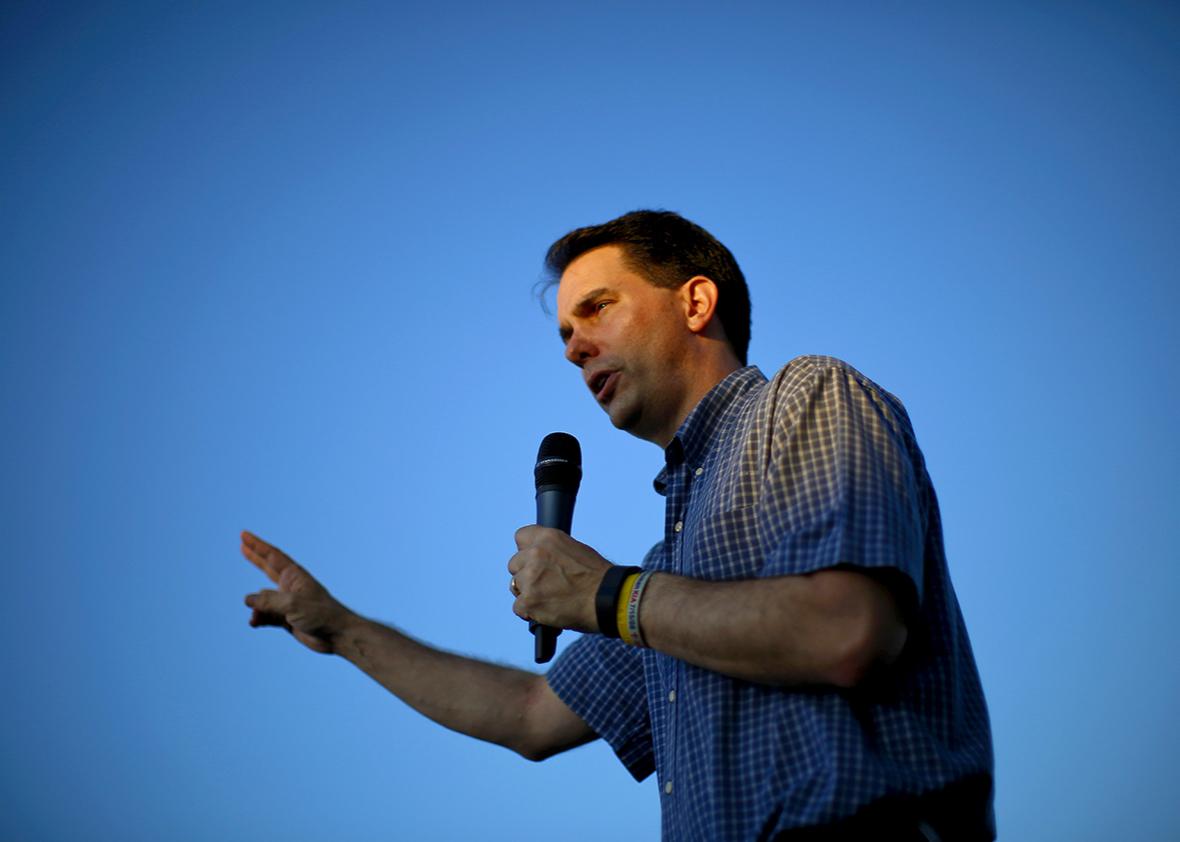As of 2014, 11 percent of all American workers—or 14.6 million people—were in a union. By sector, that’s 6.6 percent unionization for workers in private firms and 35.7 percent unionization for those in government and other public services. Just nine states have unionization rates of 15 percent or greater, down from 28 (and the District of Columbia) in 1984. In whole regions of the country, and the South in particular, unions have nearly vanished. And while as institutions they aren’t powerless—unions still carry clout in the national Democratic Party and have influence in heavily unionized states like New York and New Jersey—they’re also not strong; unions are weaker now than they’ve been in almost a century.
For Scott Walker, that’s not weak enough. On Monday, the Wisconsin governor released his plan to strangle unions, titled “My Plan to Give Power to the People, Not the Union Bosses.” The official rollout, which begins with a speech in Las Vegas, is part of a reboot for Walker’s flagging presidential campaign. After a month of low poll numbers in key states—he’s at less than 4 percent in Iowa and New Hampshire)—Walker is running with a newly aggressive message and aiming for the kinds of voters that support Donald Trump and other “outsiders.” “We need a leader who can wreak havoc on Washington and put the American people back in charge of our government,” he said in a speech last week. “To wreak havoc on Washington, America also needs a leader who has been tested. I have been tested like no one else in this race.”
Walker’s labor plan is a national version of the strategy he used to break unions in Wisconsin, although it’s far more forthright than the supposedly reluctant steps he took at the beginning of this year. He would end collective bargaining for federal employees, as per his move in 2011; he would require complete disclosure for union expenditures and total compensation of union officers; he would sign a national “right to work law” that blocks unions from making contracts that require all workers to pay dues to the union for negotating with management, whether they belong to the union or not; he would repeal wage controls for federal infrastructure projects; and he would eliminate the National Labor Relations Board, which conducts elections for labor union representation and investigates unfair labor practices.
Under President Obama, the NLRB has been more aggressive for labor than the business-friendly boards of previous administrations. In August, for example, it made it easier for unions to negotiate on behalf of workers at companies that rely on contractors and franchisees. If fast-food workers at McDonald’s or software testers at Microsoft want to unionize, employers have to come to the table to negotiate. For Walker, this decision is evidence that the NLRB is now “a one-sided advocate for big labor special interests.” As such, it needs to go, with power transferred to federal courts and the National Mediation Board, which has about 50 full-time employees, compared with more than 1,600 for the NLRB.
Perhaps aware of his anti-labor reputation, Walker’s plan is filled with pro-worker rhetoric. Unions are “union bosses” or “big-government union bosses” while anti-union regulations are called “pro-freedom” and pro-“employee’s rights.” But taken together, this is an incredible change to American labor law—a transformation that would greatly alter the relationship between employers and employees. One law professor told Al Jazeera that Walker’s plan would “go a long way toward reversing a large chunk of the New Deal,” citing language around “freedom of contract” that was used to strike labor laws and disadvantage workers.
“Any economic plan that does not bring our federal labor laws into the 21st Century is incomplete,” says Walker in an excerpt released by his campaign. “To grow the economy at a higher rate requires a comprehensive approach and reform of the labor unions is a key part of the plan.” This hasn’t been true in Wisconsin; income growth in the state lags behind the median, private-sector job growth of its neighbors, and the state has had a revenue shortfall, following his tax cuts.
Moreover, Walker’s underlying idea—that unions are deleterious to American well-being—is unfounded. Yes, there are union abuses and union corruption. On the whole, however, the opposite is true: Unions have been an important ally for middle-class workers, and the fall of labor has widened the gap between productivity and pay, and increased income inequality. According to a 2011 study published in the American Sociological Review, titled “Unions, Norms, and the Rise in U.S. Wage Inequality,” sociologists Bruce Western and Jake Rosenfeld found that the decline in union power and density since the 1970s explained a third of the increase in wage inequality among men. And a study from the pro-labor Economic Policy Institute finds that wage stagnation has been worst among groups that were unionized in previous decades but have seen the greatest decline in union membership: men and non-college-educated workers. If the past is any indication, Walker’s plan would accelerate the trend.
Walker’s plan has one clear message: He is a conservative soldier. Walker is open in his disdain for unions and frank with his commitment to conservative economic ideology, going beyond his competitors with a sweeping attack on the political and institutional foundations of American labor unions that tilts government against them and toward the interests of employers and large corporations. And whether or not Walker wins the nomination, he’s done something important: He’s put his agenda on paper and into the race, for the eventual nominee to read, consider, and possibly co-opt.
